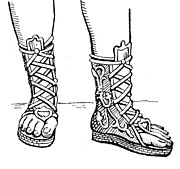Sock and buskin
This article needs additional citations for verification. (February 2024) |
Sock and buskin are ancient symbols of comedy and tragedy. In ancient Greek theatre, actors in tragic roles wore a boot called a buskin (Latin cothurnus) while the actors with comedic roles wore only a thin-soled shoe called a sock (Latin soccus).[1][2]
The sock and buskin, like the comedy and tragedy masks, are associated with two Greek Muses, Melpomene and Thalia. Melpomene, the Muse of tragedy, is often depicted wearing buskins and holding the mask of tragedy, while Thalia, the Muse of comedy, is often depicted wearing the comic's socks and holding the mask of comedy.[3]
References[edit]
- ^ "Mask (Sock and Buskin / Comedy and Tragedy)". symbolsproject.eu. Archived from the original on 2023-10-27. Retrieved 2024-02-01.
- ^ "CentreCyclopedia - Sock and Buskin". sc.centre.edu. Retrieved 2024-02-01.
- ^ Council, Stevenage Borough. "Introducing Sock and Buskin". www.stevenage.gov.uk. Retrieved 2024-02-01.


